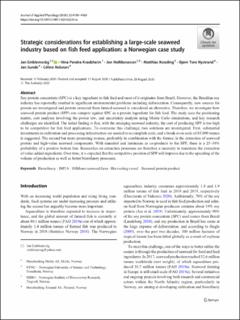Strategic considerations for establishing a large-scale seaweed industry based on fish feed application: A Norwegian case study
| dc.contributor.author | Emblemsvåg, Jan | |
| dc.contributor.author | Kvadsheim, Nina Pereira | |
| dc.contributor.author | Halfdanarson, Jon | |
| dc.contributor.author | Koesling, Matthias | |
| dc.contributor.author | Nystrand, Bjørn Tore | |
| dc.contributor.author | Sunde, Jan | |
| dc.contributor.author | Rebours, Celine | |
| dc.date.accessioned | 2021-01-26T15:19:55Z | |
| dc.date.available | 2021-01-26T15:19:55Z | |
| dc.date.created | 2020-08-10T14:05:52Z | |
| dc.date.issued | 2020-08-29 | |
| dc.identifier.citation | Journal of Applied Phycology. 2020, 32 4159-4169. | en_US |
| dc.identifier.issn | 0921-8971 | |
| dc.identifier.uri | https://hdl.handle.net/11250/2724837 | |
| dc.description.abstract | Soy protein concentrate (SPC) is a key ingredient in fish feed and most of it originates from Brazil. However, the Brazilian soy industry has reportedly resulted in significant environmental problems including deforestation. Consequently, new sources for protein are investigated and protein extracted from farmed seaweed is considered an alternative. Therefore, we investigate how seaweed protein product (SPP) can compete against SPC as a protein ingredient for fish feed. The study uses the positioning matrix, cost analyses involving the power law, and uncertainty analysis using Monte Carlo simulations, and key research challenges are identified. The initial finding is that, with the emerging seaweed industry, the cost of producing SPP is too high to be competitive for fish feed applications. To overcome this challenge, two solutions are investigated. First, substantial investments in cultivation and processing infrastructure are needed to accomplish scale, and a break-even scale of 65,000 tonnes is suggested. The second but more promising avenue, preferably in combination with the former, is the extraction of seaweed protein and high-value seaweed components. With mannitol and laminaran as co-products to the SPP, there is a 25–30% probability of a positive bottom line. Researches on extraction processes are therefore a necessity to maximize the extraction of value-added ingredients. Over time, it is expected that the competitive position of SPP will improve due to the upscaling of the volume of production as well as better biorefinery processes. | en_US |
| dc.language.iso | eng | en_US |
| dc.publisher | Springer Nature | en_US |
| dc.rights | Navngivelse 4.0 Internasjonal | * |
| dc.rights.uri | http://creativecommons.org/licenses/by/4.0/deed.no | * |
| dc.title | Strategic considerations for establishing a large-scale seaweed industry based on fish feed application: A Norwegian case study | en_US |
| dc.type | Peer reviewed | en_US |
| dc.type | Journal article | en_US |
| dc.description.version | publishedVersion | en_US |
| dc.rights.holder | © The Author(s) 2020 | en_US |
| dc.source.pagenumber | 4159-4169 | en_US |
| dc.source.volume | 32 | en_US |
| dc.source.journal | Journal of Applied Phycology | en_US |
| dc.identifier.doi | 10.1007/s10811-020-02234-w | |
| dc.identifier.cristin | 1822519 | |
| dc.relation.project | Norges forskningsråd: 244244 | en_US |
| cristin.ispublished | true | |
| cristin.fulltext | original | |
| cristin.qualitycode | 1 |
Tilhørende fil(er)
Denne innførselen finnes i følgende samling(er)
-
Divisjon for matproduksjon og samfunn [1030]
Publikasjoner knyttet til ansatte ved Divisjon for matproduksjon og samfunn -
Publikasjoner fra CRIStin - NIBIO [4575]
-
Vitenskapelige artikler [1416]

